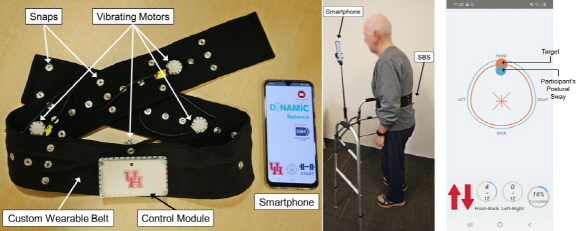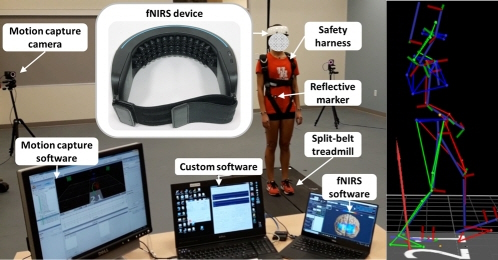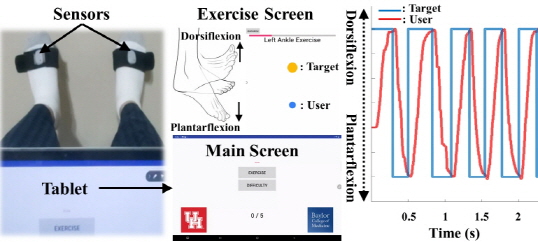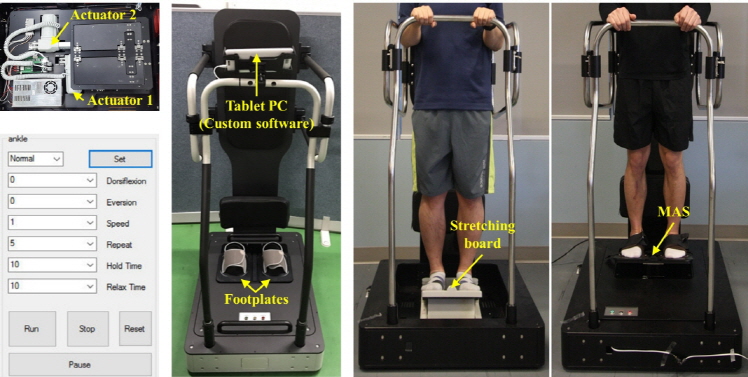Ongoing Projects and Research Initiatives
1. Innovative Neurorehabilitation System: APEX
The Adaptive Propulsion Enhancement eXperience (APEX) system was developed to transform post-stroke gait rehabilitation by targeting propulsion deficits in the affected limb. The overarching goals are to: 1) design a novel real-time system that combines visual biofeedback with dynamic propulsion promotion via a dual-belt instrumented treadmill, 2) develop two distinct propulsion modes — a propulsion-facilitating mode that prolongs ground contact time to encourage intrinsic effort, and a propulsion-augmenting mode that applies precise external force to enhance propulsive force generation, and 3) validate the efficacy of these modes in significantly improving propulsive force, propulsive impulse, lower-limb kinematics, and muscle activity in chronic stroke survivors. Experimental results revealed that the APEX system not only induces immediate gait improvements but also promotes short-term retention of enhanced propulsion, offering a scalable, adaptive, and patient-specific intervention for restoring walking ability after stroke. Integrating biomechanics, neuromechanics, and real-time control, the APEX system sets a new benchmark for personalized, high-impact stroke rehabilitation.

2. Smarter Balance System (SBS)
The overarching goals are to 1) develop the SBS that supports multimodal biofeedback (visual and vibrotactile (touch) biofeedback) and provides real-time error magnitudes with the continuous coding scheme, 2) assess the impacts on long-term rehabilitative training for people with Parkinson’s disease who receive in-home balance exercises with assistive guidance via the SBS, and 3) quantitatively and qualitatively analyze the carry-over effects of long-term rehabilitative training with the SBS on balance performance, daily physical activities, and confidence in less fear of falling.

3. A new fall-inducing technology platform
The primary goals of this project are to 1) develop a novel platform consisting of a split-belt treadmill to induce trip and slip perturbations and a real-time gait phase detection algorithm, 2) quantitatively assess fall recovery performance in response to unexpected trips and slips, and 3) explore the effects of an advanced alert cueing on fall recovery performance.

4. Exploring the relationship between trip and slip and brain activity in different population groups
The primary goal is to evaluate gait stability, recovery, and the degree to which the brain’s pre-frontal lobe is engaged in online processing during an induced fall (trip and slip) with and without biofeedback cueing in healthy young, healthy old, and individuals with Parkinson’s disease.

5. Tele-exergame
The primary goal of this project is to assess the effects of a home-based tele-exergaming platform on improvements of motor and cognitive function in cancer survivors.

6. The effects of rehabilitation training combined with assistive technologies for individuals with post stroke
The major objective of this project is to assess short and long-term effects of exercise training combined with assistive technologies on spasticity, balance, and gait performance in individuals with post stroke.

7. Machine learning-based fall risk prediction
The primary goals of this project are to 1) develop machine learning models using two-year longitudinal clinical data to predict fall risk in older adults with cognitive frailty, 2) identify key multidimensional risk factors through interpretable AI techniques, and 3) establish a data-driven framework for proactive fall prevention and personalized intervention planning.








